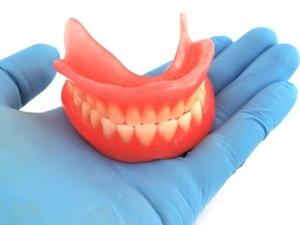 Modern dentistry has stepped far ahead. Now there is a way out, even if your teeth are not left at all and there's simply no point in fixing the plug-in teeth. In such cases, dentures on suckers come to the rescue.
Modern dentistry has stepped far ahead. Now there is a way out, even if your teeth are not left at all and there's simply no point in fixing the plug-in teeth. In such cases, dentures on suckers come to the rescue.
A decade ago, in the absence of all teeth, implants were installed in the oral cavity, to which special plates were attached. This method is unpleasant. Now there is a sparing way of fastening removable systems with the help of suckers. It is less traumatic both physically and morally.
Contents
- Design and mounting technology
- Types of materials used
- Acrylic systems
- Nylon dentures
- Structures made of polyurethane
- Indications and contraindications
- installation process Maintenance features
- How to extend the service life
- Advantages and disadvantages of
- Design
- Price
Construction andfastening technology
The product, in fact, does not have suckers in the usual sense, the prosthesis is attached to the suckers due to the effect inAukum created between the mucosa and the structure.
For its production, elastic polymer materials are used. In order to maximize the suction effect, denture inserts are made in accordance with the impression of the patient's jaw. Thus, the design reproduces the exact surface of the mucous gums with all the individual features of the structure.
The side zones of the system are worked out most carefully. In places where the jaw is in contact with the cheek or lip, the edges should overlap the transition zone by 1-2 mm. The resulting circular valve helps to fix the prosthesis carefully, sucking it around the perimeter of the entire gum. In addition, it blocks the ingress of air under it.
Due to this design, the inserted teeth on the suckers have two qualities for reliable fixation:
- adhesiveness of the - because of the complete correspondence of the prosthesis surface to the relief of the palate and gums, and also the layer of saliva located between them;
- absorption of is achieved due to a vacuum in the cavity between the structure and the mucosa.
You can use the systems on the suckers either in the complete absence of your teeth or partially. The upper jaw is able to hold the prosthesis more reliably than the lower one. This is due to its lower mobility and wide free palate surface.
For the lower jaw, special glue is often used, becauseits mobility and language do not allow to secure the system reliably.
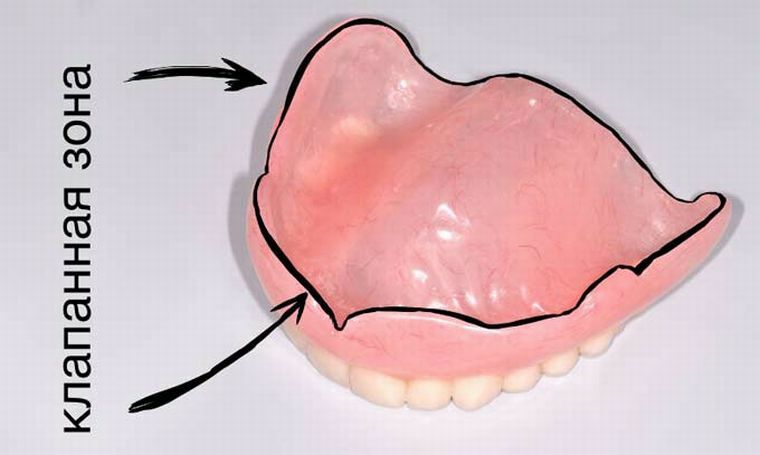
Types of materials used
When choosing the material of the future prosthesis on suckers, the doctor's recommendations are taken into account and the patient's wishes are evaluated by the pros and cons of each decision. There are three raw material variations, on the basis of which insertable removable teeth on suckers are created.
Acrylic systems
This is the first generation of suction structures. Products made of acrylic plastic can fully simulate the appearance of teeth and gums. They are produced by the method of injection molding.
On the inside of the prosthesis is a silicone insert, designed to evenly distribute the load when chewing. Such products are durable, simple and inexpensive.
Despite the positive qualities, acrylic systems have drawbacks:
- in the composition is poisonous acrylic methyl ether, which is a strong allergen;
- mechanical stress can easily damage it;
- porous structure of the material is a favorable factor for the development of pathogenic microflora, which causes bad breath.
Nylon prosthesis
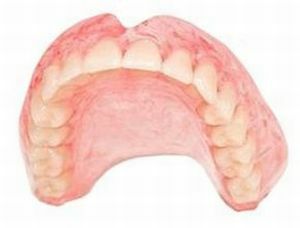 Constructions from this material do not have hygroscopicity, which blocks the development of bacteria. They are elastic, less traumatic for the oral mucosa, are the most similar to the appearance of these gums and teeth, are not stained, better sucked, withstand severe chewing loads, and have a long service life.
Constructions from this material do not have hygroscopicity, which blocks the development of bacteria. They are elastic, less traumatic for the oral mucosa, are the most similar to the appearance of these gums and teeth, are not stained, better sucked, withstand severe chewing loads, and have a long service life.
Nylon does not cause allergies, and products from it can be installed even on weak gums.
The disadvantages are:
- for cleaning the prosthesis you need to use only a special solution;
- can not be cleaned with a toothbrush;
- if the structure is broken, it will require its complete replacement.
Polyurethane constructions
For the production of removable teeth made of polyurethane, flexible plastic is most often used, which is called "dentalur".
Polyurethane constructions are flexible and flexible, perfectly sucked to the jaw, durable, strong, non-hygroscopic. The material is hypoallergenic, it does not deform when subjected to high loads and high temperatures. Have an acceptable price, durability and durability.
It is possible to make a prosthesis for the entire gum and the sky or partially. At the same time, the sky remains open, without blocking access to taste buds. This option is possible if you have several of your teeth.
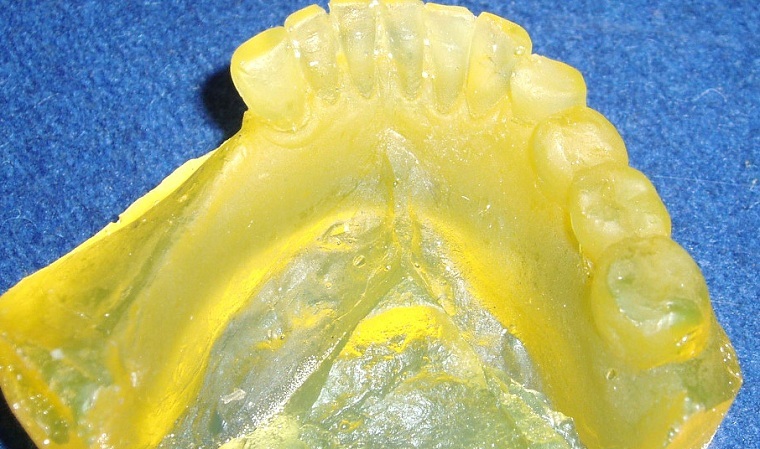
In the picture polyurethane teeth for prosthetics on suckers
Indications and contraindications
Artificial dental structures are recommended to be used in case of loss of their teeth( full or partial).Their absence may be due to injuries, illnesses or indications for removal.
You can not put suckers to those people whose gingival mucosa is damaged or inflamed. Virtually all contraindications are temporary and after recovery you can safely install the design.
Installation process
Before installing the prosthesis it is necessary for the doctor to make a cast of gums. On this impression, the necessary article from a suitable material is made.
After that, the specialist checks the reliability of the structure, its fit. At this point, the patient can see how the denture is attached. Further installation is done independently at home.
Features of care
Removable dentures can be worn constantly and remove them only for cleaning. Here everything depends on how comfortable they are in the 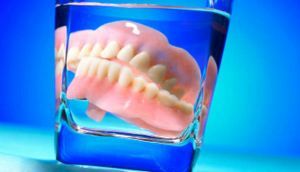 .For the storage of structures there are special containers.
.For the storage of structures there are special containers.
You need to take care of the product in the same way as your own teeth. Once or twice a day, use a brush. For these purposes it is better to purchase a special brush, which allows you to care for the basis and teeth. The cleaning agent is a usual toothpaste.
Once every 5-7 days, it is necessary to immerse the structure in a disinfection liquid. This is drinking water with the addition of special tablets that dissolve in it. The prosthesis is soaked in this solution for several hours or overnight.
How to extend the life of the
As a rule, a guarantee is given to the prosthesis, by which it can be changed to a new one. This is possible only if all the rules of wearing are observed. Here are the rules by which you can use the prosthesis as long as possible:
- daily brushing;
- weekly disinfection;
- Avoiding jaw blows and injuries;
- regular visit to the dentist.
Advantages and disadvantages of
Each type of prosthetics has its advantages and disadvantages, dental prosthesis on suckers has such positive aspects:
- aesthetic qualities, - the products repeat all the bends of gums and teeth, as well as their natural color;
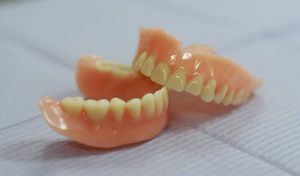
- comfort in use, becauseelastic prostheses;
- reasonable cost;
- quick and easy adaptation period;
- safe design eliminates trauma to the tongue, cheeks, gums;
- products do not rub on suckers, after a period of adaptation the patient does not feel any discomfort;
- have high wear resistance;
- effectively produce chewing and speech function.
Disadvantages of suction structures:
- unreliable fixation on the lower jaw;
- allergenicity of some of the materials from which the prosthesis is made;
- the need for a special brush for effective cleaning;
- at the first time there may be a vomitive reflex.
Viewpoint
Reviews of former patients of dental clinics who have already inserted false teeth on suckers for more than a year.
After the birth, problems with teeth began. They became brittle, broken off, blackened. So gradually by the age of 60 I lost all my native teeth.
Prosthesis of each unit is expensive, so I decided on a nylon prosthesis with suckers. On the upper jaw is kept perfectly, and with the lower periodically falls, so I bought a special glue.
Eugenia, 65 years old
Always postponed a visit to the dentist, applied only in emergency situations( basically the decision was already removal).Later, problems with the gums began and teeth "fell" themselves.
The dentist said that individual units of my gum will not hold. Therefore, the only way out for me is a prosthesis on the suckers. The first time was unusual, but later I got used to the prosthesis and I do not feel it.
Vladislav, 50 years
Price
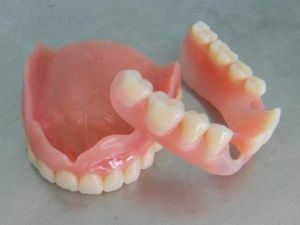 The price of the denture includes the cost of the material for the area of the gum, fixtures, set of teeth and, if necessary, additional materials. The cost may increase if there are individual features of the structure that require additional materials or work in connection with this more laborious. Nylon prostheses are made abroad, accordingly, the price for them is higher.
The price of the denture includes the cost of the material for the area of the gum, fixtures, set of teeth and, if necessary, additional materials. The cost may increase if there are individual features of the structure that require additional materials or work in connection with this more laborious. Nylon prostheses are made abroad, accordingly, the price for them is higher.
The cost of an acrylic denture for one jaw varies from 15 to 20 thousand rubles, the price of a nylon construction on suckers will be about 18000-25000.Single prostheses from nylon for 1-2 teeth will cost approximately 12-16 thousand rubles.
When problems with teeth begin, in most cases the price of the prosthesis is in second place, and the problems of restoring the chewing function and the aesthetic component of the appearance appear on the first.
